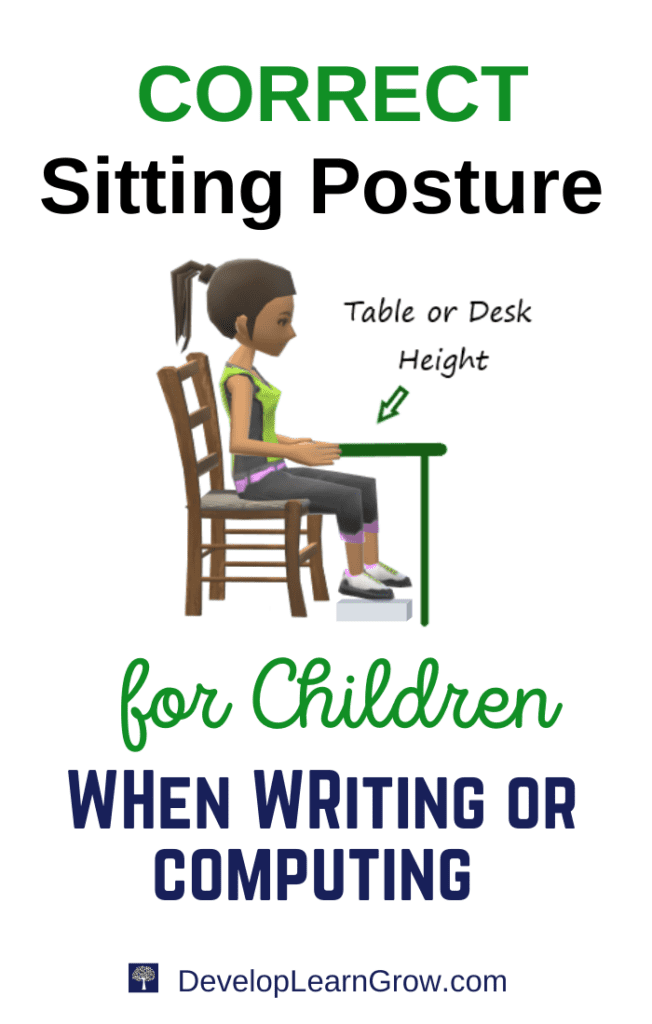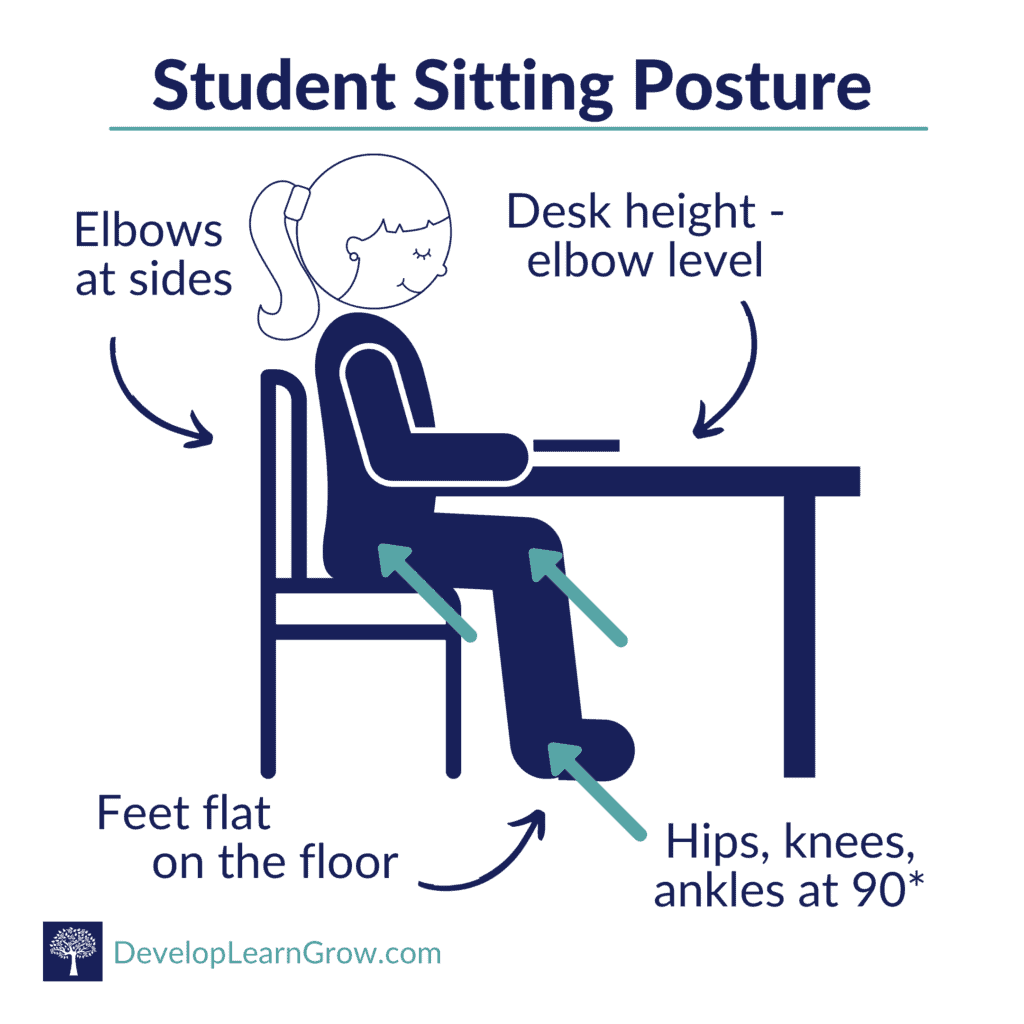What does correct sitting posture look like? And why does it matter? Kids use their hands and eyes more optimally when seated properly. Appropriately sized furniture is important for student success.
I often evaluate students for handwriting or fine motor difficulties in the school setting. As part of the screening / evaluation, I make sure I look at them in their classroom.
It’s important for me to see the size of their chair, the height of the desk and how they sit to complete motor tasks.
Many shorter students often can’t even see what’s on their desk. And even ‘taller’ students are placed at bigger desks that are actually too high for them as well.
It impacts their success with reading and writing.
The eyes need an appropriate angle and presentation of learning materials. Proper sitting posture improves comfort, reduces fatigue, and allows the hands to work more functionally.
The same thing applies when I work with babies and toddlers in the homes. In order to ensure success with self-feeding skills, the family and I start with proper positioning and supports!

Why is Correct Sitting Posture Important?
Correct sitting posture makes a difference in how your students use their hands for daily tasks. And, it makes a difference in how they’re attending and focusing.
If your student is sitting upright for certain tasks, they’re naturally using core muscles. With support at the core, breathing is easier. And they’re in a better attention position.
Good breath support gets more oxygen to the brain! Naturally, this helps the brain focus better.
It’s really important that chair and desk (or table) height are appropriate in size.
This allows for better visual presentation of materials. More importantly, when neat handwriting is required, the hands grasp more functionally when correct sitting posture is encouraged.
Having the feet flat on the floor gives stability through the lower body and the core. Stability is necessary for adequate mobility of the hands.
This reduces fatigue and allows the hands to move more freely (and it helps reduce excessive pencil pressure in some kids.)
[Test this out by kneeling at a table or counter that comes up to your collarbone. Try to chop food, write a paragraph, or draw / color. It’s a little awkward and uncomfortable!]
What Does Correct Sitting Posture Look Like?

Your student’s chair size should allow:
- Feet flat on the floor
- Ankles at a 90* angle
- Knees at a 90* angle
- Thighs parallel to the floor
- Hips at a 90* angle
- Lower back should have a slight inward curve
Your student’s desk / table height should allow:
- Shoulders relaxed
- Elbows resting gently along the sides of the body
- *Surface height AT elbow level (when elbows are resting at the sides), OR up to 1-2 inches above elbow level (depending on the size of your student)
Finding the correct surface height can be a challenge. Many desks and tables can be lowered. If the height is still an issue, a taller chair can be used with support under the feet.
Supports under the feet can include a sturdy rectangular box, an old thick book or Styrofoam wrapped in decorative tape, a stack of thinner books, or wooden blocks.
How Do You Encourage Better Sitting Posture with Your Students?
Positioning every student optimally can be a challenge. There’s only so much furniture available in your school!
I encourage teachers to check every student at the beginning of the school year.
As the year progresses, some modifications might need to be made. Especially for the students who struggle with fine motor control.
If you have a writing center in your classroom, having firm cushions or large books / boxes available can help. Start saving your Amazon boxes!
Adjust desk height and match chair size to help position your student as best as you can.
Discuss correct sitting posture with your students. Encourage them to find a chair and table of adequate size at home for homework.
Considerations Regarding Seated Posture
This is an ideal position when good handwriting is a focus.
You may see some students with slight variations or preferences when sitting:
- Students who are shorter than average may need to sit on their feet in a kneeling position. (This was my daughter’s preferred position during her K-2nd grade years. It raised her up so she could see her papers better. And, she was able to use her hands easier.)
- If a child has shorter legs, sitting at the front edge of the chair can help. The feet are then able to remain flat on the floor.
- Other students may prefer to have one foot flat on the ground and the other tucked underneath them in the chair.
- I’ve also known of some students who sit on one leg and ‘stand’ on the other.
- Or, some students may prefer to have their feet hooked around the legs of the chair.
This added input to the feet and legs (proprioceptive input) gives more stability and also helps them focus better!
It’s also important to get your students up and moving. I always encourage changes in position as much as possible throughout the day!
If your students need more postural support, check out the suggestions in Vertical Surface and Floor Activities to Improve Core Stability (a free printable is available on this post!)
Or check out the 40 Fun Core Strength Exercises for Kids.
For More Information
During computer use, read Best Position for Computer Screen (How to Prevent Neck, Back and Eye Strain During Screen Use ). The tips are important, but it’s also important to LIMIT SCREEN TIME.
This article from How We Montessori includes a diagram and a photo of a child with correct sitting posture (if you need a better model than my computer drawing!)
My Brain Break FREE Printable includes postural exercises that will activate muscles needed for correct sitting posture and breathing.
Pin this to your favorite teacher board on Pinterest to help your friends, colleagues and parents find it!



0 Comments